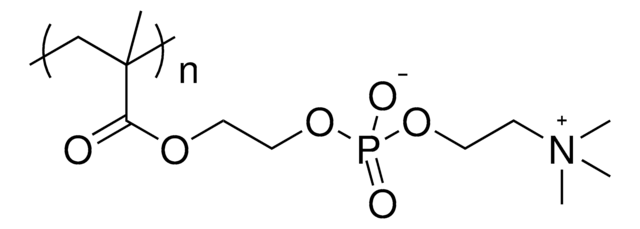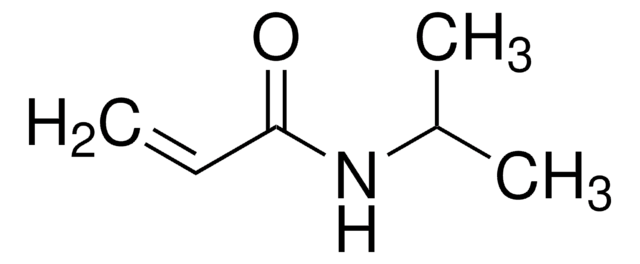925640
Poly (ethylene glycol)-block-Poly (sulfobetaine methacrylate)
PEG average Mn 5000, PSBMA Mn 13,000
Synonyme(s) :
PEG-PDMAPS, PEG-PSBMA, PSBMA, Poly (sulfobetaine methacrylate)
Se connecterpour consulter vos tarifs contractuels et ceux de votre entreprise/organisme
About This Item
Formule linéaire :
CH3(C2H4O)nC6H7O2N(C11H21O5NS)mOH
Code UNSPSC :
12352112
Nomenclature NACRES :
NA.23
Produits recommandés
Poids mol.
PEG average Mn 5000
PSBMA Mn 13,000
Niveau de qualité
Catégories apparentées
Application
Biocompatible, non-fouling block copolymer composed of a neutral PEG block and a zwitterionic poly(sulfobetaine methacrylate) (PSBMA) block.
Poly(sulfobetaine methacrylate) (PSBMA) is a well-known zwitterionic polymer, it is non-toxic and biocompatible. On each of its repeating unit, it carries both a positive charge and a negative charge, leading to its strong hydration capacity.
Surfaces coated with PSBMA showed super hydrophilic property and strong resistance to protein adsorption/bacterial adhesion, making this polymer a promising material in anti-fouling applications.
Poly(sulfobetaine methacrylate) (PSBMA) is a well-known zwitterionic polymer, it is non-toxic and biocompatible. On each of its repeating unit, it carries both a positive charge and a negative charge, leading to its strong hydration capacity.
Surfaces coated with PSBMA showed super hydrophilic property and strong resistance to protein adsorption/bacterial adhesion, making this polymer a promising material in anti-fouling applications.
Code de la classe de stockage
11 - Combustible Solids
Classe de danger pour l'eau (WGK)
WGK 3
Point d'éclair (°F)
Not applicable
Point d'éclair (°C)
Not applicable
Faites votre choix parmi les versions les plus récentes :
Certificats d'analyse (COA)
Lot/Batch Number
Désolés, nous n'avons pas de COA pour ce produit disponible en ligne pour le moment.
Si vous avez besoin d'assistance, veuillez contacter Service Clients
Déjà en possession de ce produit ?
Retrouvez la documentation relative aux produits que vous avez récemment achetés dans la Bibliothèque de documents.
Jiang Wu et al.
Acta biomaterialia, 40, 172-181 (2016-05-05)
Nonfouling materials such as neutral poly(ethylene glycol) (PEG) and zwitterionic poly(sulfobetaine methacrylate) (pSBMA) are ideal biocompatible materials for drug, especially protein drug delivery. The interaction behavior of protein between the nonfouling materials could cause great impact on their future applications
Se Yeong Lee et al.
Biomaterials research, 22, 3-3 (2018-02-17)
Zwitterionic molecules have been widely studied as coating materials for preparing anti-fouling surfaces because they possess strong hydration properties that can resist non-specific protein adsorption. Numerous studies on surface modification using zwitterionic molecules have been investigated, such as electrochemically mediated
Notre équipe de scientifiques dispose d'une expérience dans tous les secteurs de la recherche, notamment en sciences de la vie, science des matériaux, synthèse chimique, chromatographie, analyse et dans de nombreux autres domaines..
Contacter notre Service technique![[2-(Methacryloyloxy)ethyl]dimethyl-(3-sulfopropyl)ammonium hydroxide 95%](/deepweb/assets/sigmaaldrich/product/structures/217/219/73c91e1c-0ee4-4b3d-bead-a6dc3d09d1da/640/73c91e1c-0ee4-4b3d-bead-a6dc3d09d1da.png)




![[3-(2-Aminoethylamino)propyl]trimethoxysilane technical grade, ≥80%](/deepweb/assets/sigmaaldrich/product/structures/149/508/f87a9a89-f138-4c5e-9fe0-6561914241c3/640/f87a9a89-f138-4c5e-9fe0-6561914241c3.png)


![[2-(Methacryloyloxy)ethyl]trimethylammonium chloride solution 75 wt. % in H2O](/deepweb/assets/sigmaaldrich/product/structures/316/612/66b0f4cf-d060-427d-b4f5-e8fab3e5cffe/640/66b0f4cf-d060-427d-b4f5-e8fab3e5cffe.png)
